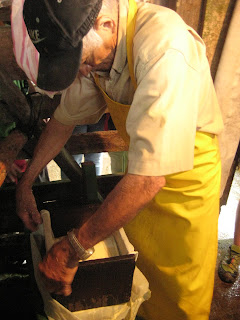July 6th
- Diversity Indices Day - sorted and identified the macroinvertebrates we collected and did a field problem data analysis set
- Watched Good Will Hunting with Alex and Ellie
- STUDIED for the midterm
- It seriously rained the entire day
July 7th
- Midterm at 10am - took it in the library with Ellie. It was a super hard exam with really complex multiple choice questions!
- I walked to Spanish early to stop at a little shop at the bottom of the hill from the station
- Spanish class in the afternoon - unfortunately I don't feel like my Spanish has improved greatly. I'm starting to think those classes in college were a bit of a waste since they were hardly ever focused on conversational Spanish. I feel like I'm just not cut out to learn other languages. Hopefully the homestay will help me improve.
July 8th
- Humans in the Tropics today
- First we went to a small-scale farm that had pigs, cows and chickens - the owner used to have about 20 cows and sold his milk to the cheese factory in Monteverde, but this was no longer economically viable for him so he sold most of the cows. Now he has about 5 cows that he milks and then turns the milk into cheese at his house and sells it to a local bakery. He can get more money for the cheese than he could for the milk.






Colorful eggs from their chickens - definitely didn't know chicken eggs came
in so many different colors




Some clover pictures for Mom

- Then we went to the cheese factory. Downstairs they have a dairy where I got a strawberry milkshake. We took a tour of the cheese factory - it was a pretty intense set up for such a small factory, high emphasis on sanitation whereas the old man just made the cheese in a barrel in his shed. The factory has very strict regulations and testing measures for the milk that they make into cheese. We listened to and watched a slideshow on the history of the cheese factory and how it was started by the Quakers that moved down during WWII. We got to taste some cheese and caramels made at the factory.

- Finally, we went to a pig farm that was related to the cheese factory. The pigs eat the weigh that is left over from making the cheese (along with corn mixed in). The pigs are then killed to sell as food. The idea is that the pigs serve a purpose in breaking down the wastes from cheese production and then are also an product in themselves. The pig farm had over 2000 pigs at many different ages. There were lots of cute piglets! (I obviously wanted to take one home - they're only about $50 bucks as piglets!) A few people in the group cried because of the conditions the pigs were living in. It was a fairly clean set-up for pigs to be living in, and much nicer than some CAFOs in the U.S., but it was sad to see such intelligent and curious animals confined to little pens. The pigs can only partially digest the corn, so the undigested corn is extracted from their wastes and then fed to steers, which are also killed for food. The remaining wastes go into holding ponds and are treated similarly to waste water treatment - with an anaerobic and aerobic stage - until the biological oxygen demand is at a certain level.



I want to take this one home!

- Lastly, we went to the study center and discussed sections of Michael Pollan's The Omnivore's Dilemma.
- At the end of the day, it was time to pack up and make the last phone calls to Mom, Dad, and Brandon before the 10 mile hike of death tomorrow! Oh goodness!
Thanks for the clover pictures Em, but don't you dare come home with a piglet!
ReplyDeletebut they're sooooo cute!
ReplyDelete